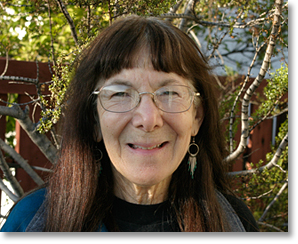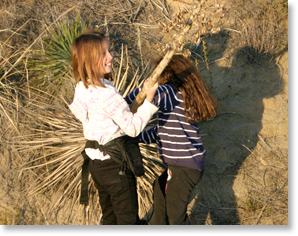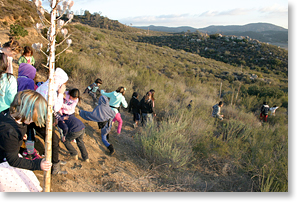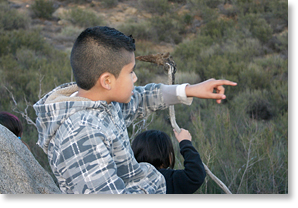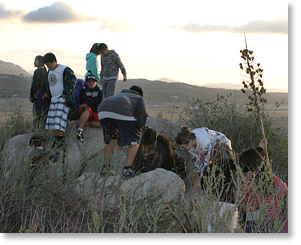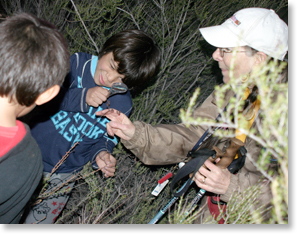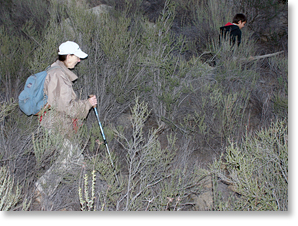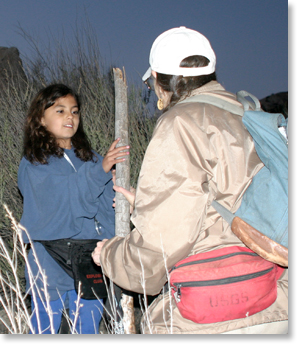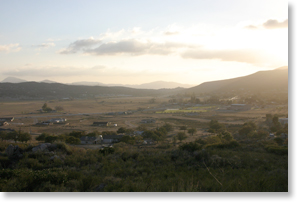|
An Interview with Dr. Eleanora (Norrie) Robbins
Mapping Connections: How to Take Care of the Earth La Mesa, California
Interview Quick Links:
Some sense of variability Norrie Robbins: My dad, Arthur Iberall, was a physicist, a systems scientist. One of the pieces of wisdom that he shared with my three sisters and me is that when you have a hard decision to make, like needing to figure out which direction you should be going in, you want to talk to three people and ask them how they solved that problem. This gives you some sense of the variability in the things you could do, and it also helps you figure out what you are going to do. It keeps you from really screwing up badly, from making mistakes. When you ask someone what they did, you also get to hear where they messed up, and that’s what helps you to sort through what you are going to do. This also saves you from asking somebody for their advice, because nobody’s advice actually solves anybody else’s problem. In Motion Magazine: I read a couple of short essays in which you wrote about the various stages of your learning: geology, palynology, paleoecology, microbiology, and Native Science. Could you please talk about why you moved along that route? Norrie Robbins: Yes, that’s a fascinating route, isn’t it? When I was ten years old, we had a creek in front of our apartment in Washington, D.C. Every time a hurricane came through, it changed the banks of my creek. When I took my first geology course from Dr. George Moore at Ohio State University, one of the things he discussed was how creeks change their banks depending on the volume and velocity of water. That explanation just sucked me up and I became a geologist. So, that was my path to geology. But I was also interested in plants. For example, at Ohio State I took dendrology, which is the science and study of trees. I had to memorize the genus and species of 202 trees. Later, when I went into the Peace Corps, I was in a mixed technical group which included five foresters. We were stationed in Syracuse, New York, to learn skills such as Swahili that we would need in Tanza-nia. It turned out that I knew the names, the genera and species, of the trees on the campus at Syracuse. I knew more than all five foresters, which was really funny. So, I really was paying attention to plants even though my degree was in geology. The interface between plants and rocks Getting into palynology is a cool story. When I was working at the U.S. Geological Survey (USGS), I transferred from D.C. to Denver. At the USGS we have The Pick and Hammer Show. The Show highlights all the ridiculous things that happened during the year, making fun of the director, the assistant director, the chief geologist, all the branch chiefs, and all the crazy things that happened during a year. Well, somebody chose me to play Estella Leopold in the show. She’s Aldo Leopold’s daughter. Because I was to play Estella, I went looking for her so I could talk to her and learn to imitate her, which I did really well. And it turned out she’s a palynologist. She was a scientist right at the interface between plants and rocks, and it just sucked me up. Estella sent me off to go study for an M.S. degree under Paul Martin at the University of Arizona. So I became a palynologist. Later I studied paleo-palynology under Alfred Traverse to get my PhD at Penn State University. Palynology was a skill of use to the USGS because we were beginning to explore for oil offshore in the Atlantic Ocean. I was doing the palynology of deep cores drilled there. It eventually became obvious to me that the age of the rocks wasn’t so important, although that’s what palynology was being used for, to determine the age of the rocks that they were drilling through. I recognized that petroleum really depended on the types of organic tissues in the rocks. It was the broken-down organic tissues that were degrading that were in the process of beginning to generate petroleum. In fact, I began to understand that those degraded tissues were from algae, especially the algae that store lipids in their cells -- lipids are fats and oils. So when burial heat causes the oxygen to break off of the lipids, what’s left is hydrocarbon. That’s the step for making petroleum from certain algae. So, after I recognized that I was working on the busted-up algae, I took algology to learn more about algae. Eventually I began to recognize that there was another piece of the puzzle sitting underneath my microscope. I saw minerals in the degraded tissues and I recognized that they were the kinds of minerals precipitated by bacteria. Well, other palynologists weren’t talking about the bacterial role in the degradation of the tissues, so I went back to school and took a microbiology course, actually several microbiology courses. Eventually, that set me learning even more about microbiology. It’s now a field of its own and it’s called geo-microbiology -- the interface between geology and microbiology. You asked where did my research go next? In the Federal government, you work in five-year increments and switch your focus to fall in line with the current administration. You do your re-search under the Johnson Administration, and then research under the Nixon administration, then the next guy. Near the end of my career, it was Clinton/Gore. Al Gore had written a book, Earth in the Balance (Ecology and the Human Spirit) and we were encouraged to read it. That was the first time I ever paid attention to the fact that I had never been taught, in all my technical training, how to take care of the Earth. I was taught exploration and exploitation of resources but never anything about taking care of the environment, and that’s where the funding was under Clinton/Gore -- the funding was on the environment. So, I started to work on acid mine-drainage in the Appalachian coalfields where the coal was causing the rivers to acidify. The mineral pyrite in the coal was breaking down in the rivers and forming bright red iron precipitates and sulfuric acid. The acid was also dissolving the manganese in the rocks and precipitating it as a brown mineral downstream. So water discharging from abandoned mines was turning the rivers red and the downstream toilets brown. The manganese was precipitating on porcelain in people’s toilets where the water came from local rivers. This happened even though they had filtered and treated the water to remove the bad bacteria such as E. coli. You do understand that when cities re-use river water, it gets treated. The water gets pumped out of a river, it gets treated, filtered, ultraviolet radiated, and then put back into domestic use. But in rural communities, people use well water which is river water and ground water. It is really hard to get dissolved minerals such as manganese and iron out of water. So rural people end up with manganese precipitating in their sinks and in their toilets downstream from all these rivers -- the Kanawha River, the Monongahela River, the big rivers of Appalachia. Most people who live downstream from coalfields end up with manganese in their toilets and it colors the toilets brown. Here’s where the story gets complicated -- the precipitation of the manganese and iron are done by bacteria. Most people think that bacteria are bad. But there are good bacteria and bad bacte-ria; the bad ones cause diseases. However, different bacteria are involved in the precipitation of the metals and in creating the chemistry of the water. Acid bacteria turn the coalmine drainage water acid and neutral bacteria precipitate different minerals in neutral pH water. So, I sort of switched over from being a geologist to a microbiologist trying to figure out how to eliminate metal-precipitating bacteria or stop the reactions so that people in Appalachia didn’t have to live with red rivers and brown toilets. I'll be a role model on a reservation In Motion Magazine: And your current profession? Norrie Robbins: Native Science. As part of taking care of the environment, I said to myself, "OK, you have a PhD in geology and you don’t have a clue how to take care of the environment." You would think that Earth Scientists such as geologists would be taught something about taking care of the environment, but that wasn’t and pretty much still isn’t part of my field. So I thought, “Who teaches their children how to take care of the environment? Indian people do. Let me go find some Native American geologists.” I had the whole United States Geological Survey at my disposal. I walked around and couldn’t find any Indian geologists and that really freaked me out. How come there were none? I started asking around and it turns out that one of the geologists who I worked with lived with a Native American woman. Her housemate was a social worker with the BIA, and Ramona Osborne is her name. Ramona came by the office sometimes, so one time I got up my nerve and asked her: "Where are the Indian geologists?” And she said, "Well, there aren’t any. It has to do with role models," she said. Like on her Pawnee reservation in Oklahoma, there were social workers and lawyers; she became a social worker. She explained, "there are no geologist role models on the reservations." I said, "OK, when I retire I'll be a role model on a reservation and see if I can influence some kids to become environmental scientists who can teach Western-trained scientists." When it was time to retire, my husband Brian said he wanted to move to San Diego and play golf at the Torrey Pines golf course. I thought to myself, "Well, I’ll go find out if there are any Indian reservations in San Diego." It turns out that we have 15 populated reservations in San Diego County. (Barona, Campo, Jamul, La Jolla, La Posta, Los Coyotes, Manzanita, Mesa Grande, Pala, Pauma, Rincon, San Pasqual, Santa Ysabel, Sycuan, and Viejas.) Indigenous Earth Science Project Luckily I found Eric Riggs at San Diego State University (SDSU). Eric had a project called the Indigenous Earth Science Project, where he was trying to teach local geology to the personnel of reservation environmental departments (and talk some of them into becoming students at SDSU). He was interested in the same thing I was: how Indian people taught their kids and how they teach about the environment. So, I joined his project and the department. He started introducing me to people; here in San Diego he sent me to Geneva Lofton Fitzsim-mons at the La Jolla Reservation. Geneva pointed me in the direction of Henry Rodriguez. I don’t know if you know that name Henry Rodriguez, but he was one of the most important elders of the Luiseño people in north county San Diego. He was friendly, loved to dance, and flirted with all the ladies. He’d been in the Army, and when he retired to his reservation, he began to realize that they didn’t have reliable water sources there at the La Jolla Reservation. He and his colleagues read through the regulations and the laws and discovered that Lake Henshaw was supposed to be releasing so many acre-feet of water to the La Jolla Reservation before Lake Henshaw water was put in the Escondido canal. Henry fixed that by fighting the case all the way to the Supreme Court and winning. Now Lake Henshaw has to release a certain amount of water into the La Jolla River so that the La Jolla Reservation can get their share of the water. Henry was really important. As I said, what I wanted to do as a retired person was to teach outdoor science to kids who live on reservations. For myself, I wanted to be taught the thought processes that you use when you take care of the Earth. I decided I could trade off, teaching kids for free in exchange for being taught. And in that manner, I could be a scientist role model on a reservation. The way I even formulated this idea of teaching kids was influenced by my sister Penni. She is a master teacher, and she said to me, “You know you get your profession at ages seven or eight.” She explains it this way: “That’s the first time you really look outward. At age six, you are focused on your mother. But not too long after that you start looking outward. Whatever you do that you are competent at, collecting rocks, painting, it sticks with you.” Of course, in between being a child and a professional, you first have to go through being a teenager, and then you go to college. As a young adult following this pattern, the thing that turned you on when you were seven or eight years old reemerges. So Penni said to me, “Aim towards seven or eight year-olds.” And I said, “OK, I will teach 7 or 8 year-olds.” You realize of course, I was a research scientist having no children. This was to become a big change in my life. When I talked to Henry Rodriguez and told him that I wanted to teach outdoor science to kids on the reservation, he said, “You want to turn them into hydrologists.” Water scientists. He said, “If you’re an Indian, you’ve got to pay attention to your water quality and your water quantity. We need water scientists. We need people who have the letters next to their names, so that others will listen.” And, that’s what I did. I started to teach outdoors science to the kids and do a lot of activities with water. But it turned out that the La Jolla Reservation is just about the only reservation that has water, because of Henry’s fight to the Supreme Court. All the other reservations, they didn’t get water because when the white people decided where the Indian people were going to live, first they checked to see if there was any gold. OK, no gold. Then they checked to see if there was water: no water. OK, that land the Indian people can have. In Motion Magazine: Do you want to talk a little about your experiences as a Peace Corps Vol-unteer in Tanzania and Kenya? Norrie Robbins: I was a Peace Corps volunteer in Tanzania, assigned to the Geological Survey of Tanzania. I eventually learned why the Survey accepted me. I was a female geologist. Right? This was 1964, and typically they didn’t want female geologists. But the Survey had millions of entries of chemical analyses from rocks collected over 60 percent of the country, all typed neatly into notebooks; this was before computers. They needed somebody to be in the office and read through those notebooks to figure out where potential mineral deposits were located. That was my job. Read through the notebooks, figure out where the anomalies were, and plot the locations on base maps. Then, when the male geologists went out for eight months at a time to map the geology of a particular region, they would take my maps with them and go check out where I had marked the location of potential mineral anomalies. When I first got there in the town of Dodoma, the Chief Geologist said to me, “You’ll niver go in the field,” in his Scots brogue. But then he went on leave and my immediate boss said, “You’ve been doing a really good job. I’m going to send you in the field.” The reason this worked was that all the guys were out in the field, and what was left behind were all the old field assistants and all the field vehicles that needed repair. After several months, the vehicles were fixed and the older field assistants were getting antsy; they wanted to go out into the field. My boss said to me, “Find somebody’s house. You have to stay in somebody’s house.” So, I plotted all the Peace Corps Volunteers, all the primary schools, the secondary schools, and all the missions. Luckily I found a Peace Corps nurse who lived in the town of Kondoa, near one of my lead and zinc anomalies. So off I went, at 23 years of age, first female in charge of a field crew in Tanzania. We actually went out twice, collecting sediment samples in the field, me and my men, my cook, and the herd of elephants, the tsetse flies, the two Cape Buffalos, and the rhinoceros. For my vacation, I decided I wanted to map for Dr. Louis Leakey in Kenya. I had gone to the Upper Mantle Rift Valley Conference in Nairobi, and I popped over to Louis’s office and said, “I’m a field mapper. I work for free, but you have to feed me and put me up.” He actually needed me and he assigned me to the Olorgesailie site. There, I worked for Glynn Isaac who was working on the archaeology of the site for his PhD at Berkeley. Later, he became a professor at Berkeley. The Olorgesailie Prehistoric Site that we were mapping is really interesting. This is an 800,000 year-old hand axe site. The people who made the hand axes were Homo erectus, and they had used local rocks to make hand axes. The artifacts were just spread around and the location of each individual one needed to be located on a map. Furthermore, I was needed to map the bor-ders of the national park which was being expanded. A lot of tourists come to view these objects. In Motion Magazine: What was the Tanzania Survey doing with all the data you were working on? Norrie Robbins:: They were looking for mineral deposits of silver, cobalt, copper, lead, zinc, etc., to mine them. At the beginning of my career, I was an economic geologist, an economic geologist working on mineral deposits. Then I became an economic geologist working on petroleum. Still later, I became an economic geologist working on coal. In Motion Magazine: So, at some point you went to feeling that extraction may not be the best approach for taking care of the Earth? When was that turnaround? Was that in Virginia where you were stationed with the U.S. Geological Survey? Norrie Robbins: Yes, it was during the Clinton/Gore administration. It started with reading Gore’s book. I began to ponder the fact that I had absolutely no skills for environmental remediation and cleaning up the environment. None of us did. We all started from scratch at the USGS because none of us had ever been taught about cleaning up the environment. But I put together a fun research team that included the (U.S. Army) Corps of Engineers. Environmental cleanup technology There was a field biologist with the Corps of Engineers, John Anderson. He was interested in mine drainage. A lot of people are interested in the subject, I think because the colors in the water from the oxidation of iron by bacteria were stunning. John figured out he could use a tool that the Corps was testing, remote sensing, to assess the chemistry of the water. When he was starting to think about remote sensing applications, scientists at the Corps were doing all sorts of research for the Department of Defense. First using remote sensing to locate warm bodies -- to learn where enemies were hiding. But people were also thinking about remote sensing the environment, like using remote sensing to spot radiation leakage. I was telling people that I could look at the different colorful precipitates of the bacteria in the water and tell if the chemistry was neutral or acid. John said if you can do it visually, we could map it using remote sensing. So we proceeded to do a whole bunch of really crazy flying over acid mine-drainage and neutral drainage in order to prove his hypothesis and this technology. He got his PhD from this project. In Motion Magazine: What was done with the results of all that? Norrie Robbins: We were doing was environmental clean up. That is, finding out where the leakage was coming from. You could trace it on the ground, driving around or hiking through poison ivy and ticks; but it is easier to actually see some of the drainage being discharged from the air. We were looking for places that the mine drainage was discharging out into the rivers. As I mentioned earlier, that was the iron part of the story. But manganese was also a significant part of my research on mine drainage. I was so lucky to be working with the famous geochemist, Moto Sato. Living in urban Virginia, he had a hot tub that was being cleaned by ozonation. He realized that the ozonation process was precipitating a black manganese rim around his hot tub. He observed this at the time that we were out in the field working on the manganese cycle. He had the brilliant insight that we might be able to clean up the metal in the rivers by using ozonation. The two of us worked on a technology that ended up getting a patent for the government on ozonating acid mine-drainage water to pull out manganese. Seven generations in the future In Motion Magazine: How did this set you up for realizing the difference between the perspective of a Western-trained scientist, which you said you were, and the Kumeyaay or Indigenous perspective? Norrie Robbins: Cleaning up the environment. The issue really is if you were doing it right, you would treat the minerals in the ground differently. You would find better mining methods. As hu-mans we don’t leave minerals in the ground, we take the minerals out. The issue is taking them out properly, treating them properly, and storing them properly. There’s a phrase that’s used in this business; it’s called best management practices -- BMPs. At the initiation of mining, if you begin by thinking that you are going to do BMPs -- best man-agement practices while you are mining, best management practices while you are processing the ore or the petroleum or the coal, and best management practices when you store the waste, then you don’t end up with a mess downstream. The companies always say, “It costs too much money to do this one extra step each time.” One extra step to make sure that you are treating the materials in the best possible way ... Being part of the Federal government, our job was to come up with some ideas for BMPs that the government could then require that the companies use. What I Iearned from Indian people illuminates that thought process -- you really need to start at the beginning. You think deeply at the beginning, you treat the land properly from the beginning because underlying all is consideration of seven generations into the future. That’s the terminology that I learned from my Indian friends. If you know that what you are doing on Earth is going to affect seven generations in the future, then you stop, think, and plan. You do these best man-agement practices so you don’t end up leaving a mess for your children, your grandchildren, and all your progeny into the future. Seven generations is just a hundred and forty years. It’s not a whole lot of years, but that’s really where your brain has to always be. How is this going to affect 140 years into the future? In Motion Magazine: How about getting to the point where you leave it in the ground? Norrie Robbins: That’s sort of hard to ask an economic geologist if she thinks everything should be left in the Earth, because I live in this technological world and I’ve been extremely well trained in exploitation of resources. You don’t turn to a geologist and ask, “How do you leave things in the Earth?” My brain couldn’t even figure out how to think like that. Sustainability: management practices In Motion Magazine: What is sustainability? Norrie Robbins: Sustainability. Well, that’s a great question, what is sustainability? To me it’s best management practices. And you know what? That would come out of my dad’s mouth also, because being a systems scientist, he always explained things in terms of complex processes that interacted with each other by cooperation, competition, or neutral responses; he also taught us to think about how do you manage the interactions? How does a system get managed so that it sustains itself? For example, one of the ways that he taught us this was by thinking about your life span. You can have a crazy life, and then you can crash immediately and die. Or you could have a life where you are a little bit more cautious and manage carefully when you are on the down side of the life-span curve. Rather than driving yourself down fast by overeating or smoking, you can slow the whole process down. You can manage the down part of the curve. That’s what he taught us: the management of the degradation phase. Personally, I translate this into the three ways people are taught to behave by their parents: with prudence, by risk taking, or by fatalism. I suspect that two of these behaviors tie right into the problem that some people are having coming to grips with climate change -- the belief in fatalism or the behavior of risk taking. My family taught prudence. Dad always taught systems behavior in terms of the birth, life, and death of a process, of a complex process. Birth is a fast process, life is a slow process, and then the death process can go either fast or slow. You know, the star explodes, or the person smokes. Or the opposite, deg-radation can go slowly, the sun can die slowly, a person can live a long healthy life like my mom who is now 100 years old. That’s where the management issue comes in. Dad pointed me in the direction of geology by asking what was the time scale for the birth phase? What was the time scale for the living phase? And what was the time scale for the degradation phase? To me, sus-tainability is management of the degradation phase. Managing isn’t a perfect science, but in terms of managing the resources, I have a story to share. I went to a talk yesterday by Dr. Theresa Gregor from the Santa Ysabel Reservation. She was interviewing for a position at San Diego State in the American Indian Studies Department. Her lecture was about Delfina Cuero’s book (Her Autobiography). Delfina explained in great detail about how they were out looking for food all the time after the Europeans chased the Kumeyaay off their traditional lands. If food becomes the number one issue in your life, then you have to pay very careful attention to everything that might be edible around you. Before being chased off their land, they knew how to manage the grasses so that deer come back and how to manage the oak trees so that the acorn crop was healthy. Protein sits in many forms -- in plants, in rabbits, in mice, and in insects. When you are living at the survival level, especially if you are living closer to the survival level than we are right now with our row crops and grocery stores, you’ve got to be doing some really tight management. That’s what sustainability was to early Indigenous people. It was tight management of the plant and animal resources. In Motion Magazine: Your various fields of science relate more to life than rocks. It’s what’s in the rocks, remnants of life, whether it is societies of plants or societies of people. This seems to be about an understanding of the system of biodiversity. Norrie Robbins: Exactly. Well said. It’s looking at biodiversity, although geologists don’t think of it as biodiversity. But what my field of palynology does show is the shifting vegetation or biodiversity through time. For example, in sediment cores you can tell when Native people came to North America because they changed the vegetation. The best studies of that were done by the phyto-sociologists who were working in New England. They showed that when the original people came, they started cutting down the trees that didn’t have edible mast crops ("fruit of forest trees like acorns and other nuts."), trees that weren’t useful or didn’t have food attached to them. They started cutting down those that had big root systems, because walking around big root systems in the forest is a big butt pain. They eliminated those trees. And you can see that in the palynological record, in the fossil record, when those trees were eliminated. And you can tell when the Europeans came and brought their cows and the weeds attached to their cows. They cut down the forests and they changed the vegetation too. In cores, you can see when the Europeans showed up, because of the big spike in weed pollen -- the Europeans are weeds (isn’t that funny?) as seen in the pollen record. The massive cutting of the forests also led to massive soil erosion. Sedimentation is what we call this in geology, when dirt and soil start moving downstream. Sedimentation increased when they cut the trees that held the soil in place; and their cows were eating the vegetation and their hoofs were messing up the soil and so sedimentation increased, filling in the coastal estuaries. When you see a whole lot of sediment in a core, that peaks the interest of geologists. In Motion Magazine: Do you want to talk some more about the Science Explorers Club? Norrie Robbins: Science Explorers Club, that’s my favorite subject on Earth. Last year, I was teaching on eleven reservations. And my gas was funded by the National Science Foundation for the past eight years. It was really easy to get onto reservations because what I said was, “I will teach your kids in a free program, having the objective of getting them interested in the outdoors and science, and moving them in the direction of going to college. And there are jobs needing this expertise on your reservation.” That resonated with the education directors and the tribal councils. I didn’t have any trouble being accepted on any reservation. For the past 13 years I have worked either with recreation directors or education directors. I teach about 400 kids a year. Right now I am teaching this monthly program on six reservations. I take the kids out and get them wet and dirty. That’s the beginning of science. That’s what my sister Penni taught, get them wet and dirty. I’m nice, I do warn the parents. I let the seasons be in charge of what we do. We do a couple of formal things. All the kids participate in the Great Southern California Shakeout (http://www.shakeout.org), that’s the month of October when I teach earthquake science. We learn about earthquakes indoors and outdoors; outdoors we search for cracks. We involve the reservation fire department, if they want to be part of it. In November, we participate in World Water Monitoring Day; this is a worldwide activity with kids using testing kits. The kids test the pH and the oxygen levels and learn if there is dirt in the water (the turbidity). On the reservations that allow their data to go online, I submit their data so that kids participating in Africa, in Poland, and in Connecticut can learn that other kids are doing the same testing. It’s a worldwide event where kids are taken out into their creeks. Or here in San Diego where we don’t have creeks … November is a terrible time for us because we don’t have any water… typically we will use the hose. Of course, if the hose contains water pumped from the ground, it has no oxygen in it, so our kids measure zero oxygen in their water. But, the kids at the La Jolla Reservation have water in the San Luis Rey River, so they get to measure oxygen in their water. December, it’s cold and getting dark outside so we typically we will do mountain climbing. I’m an after-school program, so sometimes when I’m teaching from 4:30 to 6 PM during the winter, we are out with flashlights. The Pauma Reservation program is from 3 to 4:30 PM. It’s still light outside in the winter so they haven’t had the pleasure of being out with flashlights or cell phones with flashlights on them. Sometimes whichever reservation is the end of the month, that’s Christmas so there is no program and those kids end up mountain climbing in January. This February I decided to start teaching about drought. So for my February program at Barona, it ended up pouring. The fabulous director at Barona, what does he do? He pulls off his backpack and brings out ponchos for all the kids, dresses them, and we just kept moving. So that was my first crazy attempt at teaching 6 to 9 year olds about drought. They need to learn this, we all do. Since 900 AD, there have been three droughts that lasted longer than 200 years each. Their ancestors made it through these droughts; we need to learn how. March, we’ll do signs of spring. April or May we do Spring wild flowers. June is typically animal tracks and trails. July we dig for water, to learn about groundwater. In August, the kids often have a beach day, so we pick up kelp, shells, and sand critters. In September we do rocks and crystals. I bring rock hammers and facemasks and the kids learn how to break rocks to see the difference between the weathered outside rock surfaces and the fresh inside surfaces. They collect rocks, they collect crystals. The geologists-to-be carry home bags and bags of rocks. That’s what the year looks like with the kids. In Motion Magazine: The other day, when I joined you at a Science Explorers Club, I watched with amazement as a young girl ripped out of the ground a six-foot, dried out yucca stem. And so you talked to them about yuccas. Tell me about yuccas. Norrie Robbins: Well, the yucca plant is a lot of things. Yucca was one of the really important foods. You eat it before it flowers; this is when the stalk first grows up, looking like an asparagus. Before the flowers come out, that’s when you cut it down and slice it up. You can either roast it or you can eat it raw. We eat it raw. If it has already flowered, then we’ll eat some flowers. The flowers have an insect that live in them; ancestors used to eat the insects because that was protein. But the kids don’t want to eat the insects anymore, so we don’t eat the insects. The dead stalks were used as quivers to hold arrows; the fiber from the leaves made cord and string. For kids, dead stalks are giant sticks. Boys in general are crazy about sticks, girls less so. But maybe we have a budding botanist on that reservation. The leaves of yucca are really pokey, and so the kids get hurt. They get poked, and so they learn. They have to learn all the outdoor skills. There are other outdoors plant skills they need: don’t touch the cactus and stay away from the poison oak. These are important outdoor skills, along with learning safe behavior around rattlesnakes and mountain lions. In Motion Magazine: You wrote in one of your essays online that you need a lot of girlfriends to get through the icky parts. Norrie Robbins: Oh, I wrote that when I was working. You know in the work environment, in the male world of geology, it’s a world of competition. You have to have a lot of girlfriends to put your ego back inside your body because it’s been slapped down. I’m a retired woman now; I don’t have to deal with much male aggression. In Motion Magazine: Do you want to talk about Women Occupy San Diego? Norrie Robbins: Women Occupy San Diego is so much fun. Occupy Wall Street did something so wonderful for us. It brought all of us political activists together, all the brave women, not the women who stay home and write letters to their Congress people (which is really important too), but all the brave women who are willing to put their bodies on the line and stand up and talk to police and to politicians. It brought us all out of the woodwork. There were three populations I saw at Occupy. The young adults were really angry, they are getting shafted big time. Us older women, we sat around at the periphery, talking with each other and making friendships. And the third population was the homeless people; they called us the home-more people. At Civic Center, the homeless were essentially occupying the space for the people who didn’t want to sleep out. They were the people sleeping over, they were our allies, mostly they were the people who were getting beat up by the police. We learned that they don’t have very much food. They go to food banks to get food. So, the first thing we older women did as a group was to start bringing food. We did this on Sat-urday afternoons. One member brought her fabulous brownies; I was the banana woman. I brought bananas for everybody. Food became a female bonding experience. And from that start, the political activists among us said, “Let’s get organized and actually ac-complish something useful.” We organized ourselves into Women Occupy San Diego. We also got organized into the singing group, The Occupellas. Some of our group turned out to be absolutely hilarious songwriters. Everyone is welcome to join us. We meet every month, we have an agenda. We divided ourselves into committees such as: Money Out of Politics to start reversing the damage done to our Democracy by Citizens United; San Onofre to make sure that taxpayers get the $92 million back after we helped shutdown the nuclear power plant at San Onofre. And another group is Food Justice, working to organize getting healthy foods to underserved neighborhoods. Another committee is Violence Against Women, and we also participate with 350.org to stop the Keystone pipeline. Our big push now is to help get homeless vets services and into houses. And there’s one other big action, the TPP. I’m on that committee to make sure that the Trans-Pacific Partnership trade agreement never gets fast tracked or signed. I’m really aggravated with the TPP because it’s going to wipe out environmental regulations in the United States. Here’s what the TPP says: any company that declares that an environmental regulation will cut into their future profits can sue to get rid of that environmental regulation. The 600 corporations that wrote the Trans-Pacific Partnership agreement want to get rid of environmental regulations in the United States, such as best management practices to remedy acid mine-drainage. Published in In Motion Magazine May 2, 2014
|
||||||||||||||||||||||||||||||||||||||||||||
If you have any thoughts on this or would like to contribute to an ongoing discussion in the  What is New? || Affirmative Action || Art Changes || Autonomy: Chiapas - California || Community Images || Education Rights || E-mail, Opinions and Discussion || En español || Essays from Ireland || Global Eyes || Healthcare || Human Rights/Civil Rights || Piri Thomas || Photo of the Week || QA: Interviews || Region || Rural America || Search || Donate || To be notified of new articles || Survey || In Motion Magazine's Store || In Motion Magazine Staff || In Unity Book of Photos || Links Around The World NPC Productions Copyright © 1995-2018 NPC Productions as a compilation. All Rights Reserved. |


